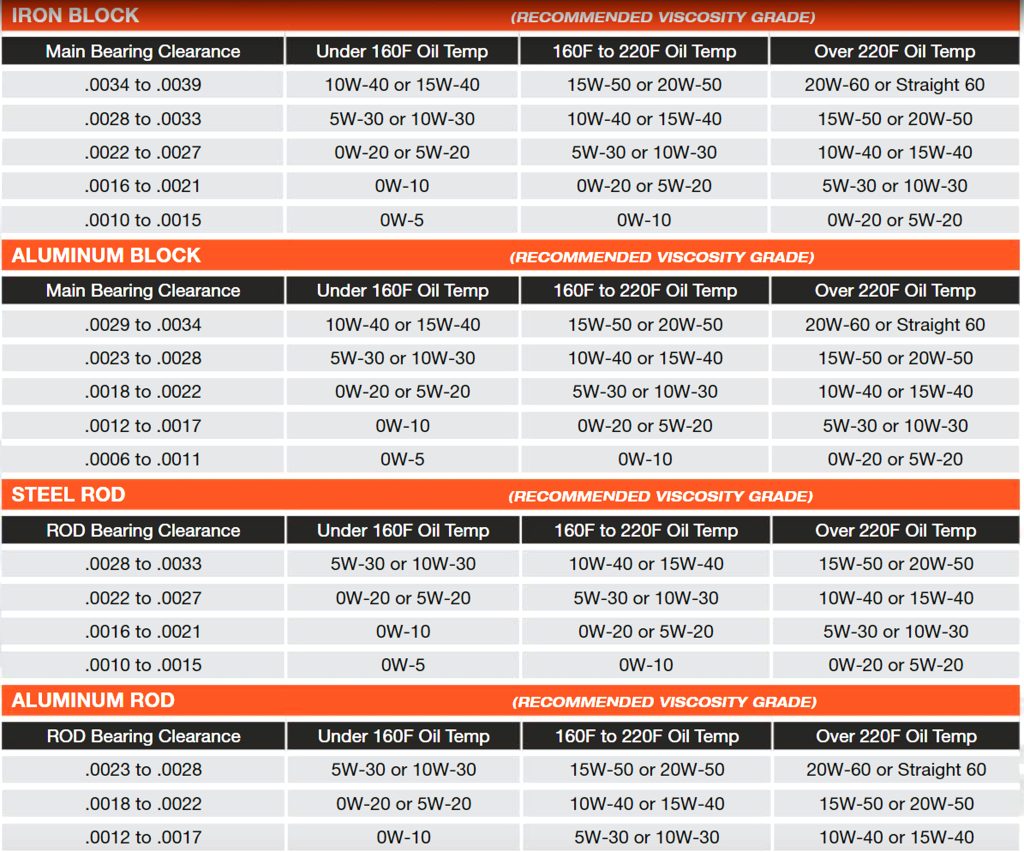I read your story on what weight oil to use for a certain bearing oil clearance. Thanks for a good article,
Here’s a question for you. Would you look at using the same table of clearances and oil temp for an old splasher engine?
On a different note, my ‘89 Corvette runs hot, oil temps over 210 and if I’m driving it hard they go even higher. Fortunately it has an oil pressure and engine oil temperature gauge so I can and will be shortly switching to 5w40 synthetic from 5w30 synthetic. Now if I change thermostat and when electric fans come on it will help to thicken the oil and increase the oil pressure.
B.S.
Oil Viscosity & Engine Temperature
In regards to your Corvette—a 5w40 is likely a good selection but there are many levels to the relationship between oil temperature and oil viscosity. A 210 degree F oil temp is just about right for most street engines as oil temp will almost always be higher than coolant temperature because oil is also cooling the engine. As long as the engine oil does not spend too much time above 225 degrees F, a mineral oil is fine at 210 degrees F.
Synthetics are a great alternative if the temp concerns you—or you can add an oil cooler to keep temperatures in line. But remember that 212 degrees F is where water evaporates which turns the water into steam where it can be removed via the PCV valve. Water enters the crankcase as an inevitable byproduct of combustion. Water easily combines with acids and if allowed to concentrate can cause bearing etching difficulties for the engine. Plus, a higher oil temperature also helps to reduce sludge buildup inside the engine which is caused when water mixes with oil and solidifies.

Viscosities & Bearing Clearances for Oil “Splasher” Engines
When referencing splash-lube engines, I will assume you are referring to early automotive engines like the Model A’s four cylinder that used scoopers located on the connecting rods to pick up oil from the oil pan. I did some research and discovered that centrifugal force is used to direct oil through a galley that then gravity feeds oil to the main bearings.
This sounds implausible but it does work.
I have zero experience with splash-lubed engines. Your question would best be addressed by guys who build those engines. I searched around on the internet, which can be a dangerous thing, but after verifying the information from several sources it appears that the Model A used SAE 30 mineral based oil.
A lower viscosity oil might seem like a good idea since it would move with less resistance, but then when the engine gets hot, it will be less likely to properly protect the bearings. It appears from what I can discern from the internet that main bearing clearances are relatively tight at around 0.001 to 0.0015 inch for these engines, which is another reason to run a multi-grade oil which will help to protect the bearings when the engine is cold, especially if run with temperatures below freezing. This seems a bit tighter than I would have thought but again I have no experience with these engines.
The Driven Racing website chart on viscosity versus oil clearance recommends a 0w10 assuming clearances are between 0.001 to 0.0015 inch. But a multi-grade oil like a 5w30 could also work well since it will flow more easily during cold engine operation yet it would still protect when the oil temperature rises.

I am in Ontario, Canada. It was Winter and my oil which was 5W-30 would turn to molasses and the motor wouldn’t crank even with a fully charged battery. So keep in mind this was in the 1980’s where 0W-30 and the like were not even invented yet. So I thought long and hard on this and decided to try mixing oil with my regular 5W-30. My engine was a 305. So I tried a 70/30 mix, and magically I had the only vehicle that would run in the winter. The community had no electricity yet but the do now. Just a FYI.